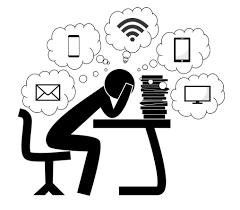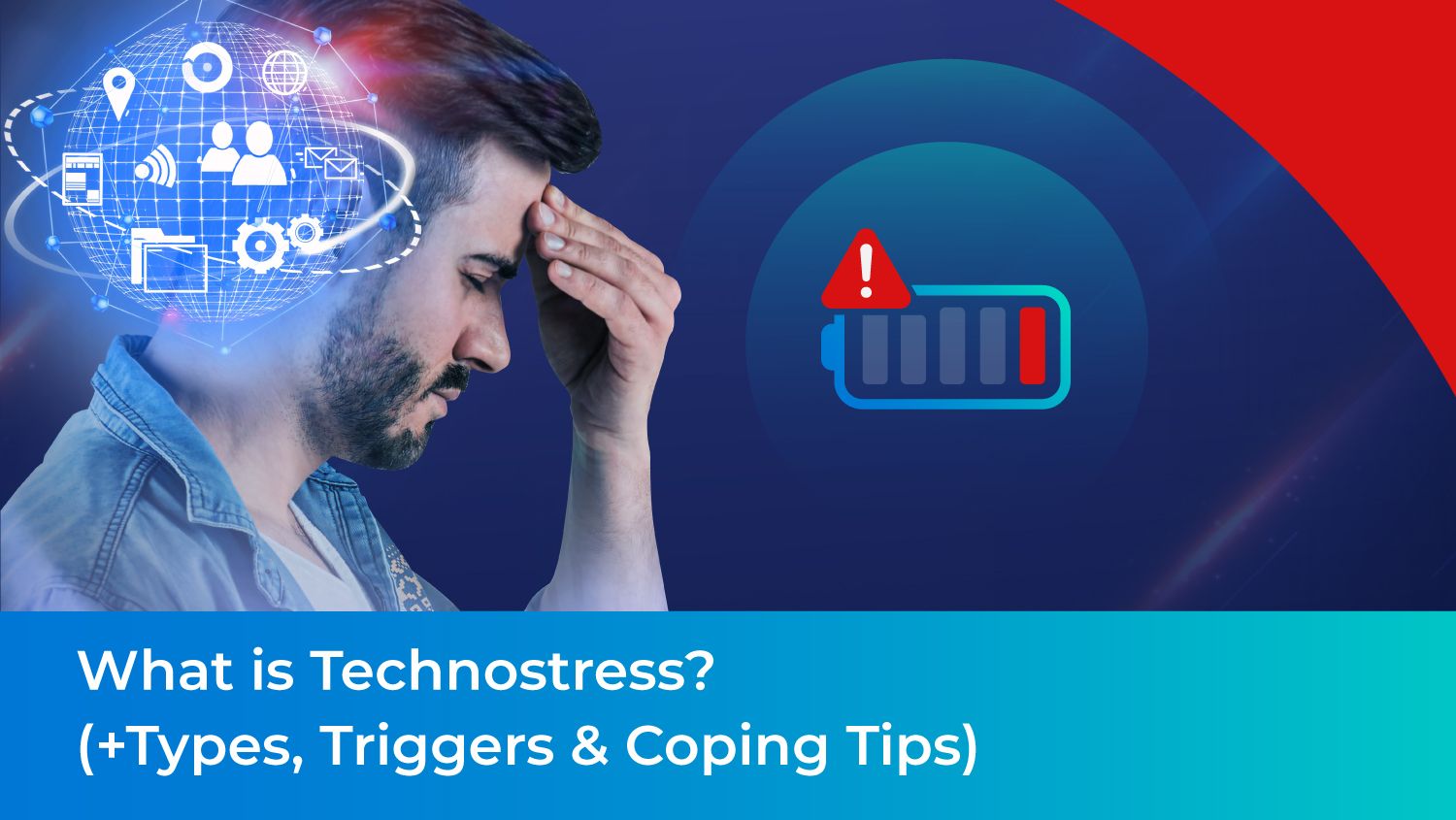What if we told you that the technology designed to make our work lives easier could also be the source of our stress? That's the paradox of technology in today's digital workplace.
However, if we fail to address this issue, it can significantly impact our ability to work effectively. In 1984, Craig Brod identified and coined a term for this phenomenon: "technostress."
Technostress, as Brod describes it, is the emerging challenge brought on by the nonstop involvement of technology in the most basic and daily work routines.
Think about it: from navigating websites for research to logging into multiple software platforms or managing tasks and deadlines, our work lives are closely tied to some form of technology.
When the pandemic hit, working from home became the new norm, increasing our reliance on technology. Further, we saw an intensified imbalance between our personal and professional lives due to this digital shift(causing more distress).
Throughout this blog, we will examine technostress, its triggers, causes, and impact on our happiness and productivity at work.
P.S. Keep an eye out for the practical coping tips!
What is Technostress?
Technostress is when a person feels anxiety, frustration, or uncomfortable physical and psychological reactions when using new technology. This phenomenon stems from the constant evolution of technology, which can be challenging to keep pace with.
This ‘person’ can be anyone – from your customers, partners, or, most impacted, employees.
For Example: Imagine you’re a remote sales manager. Facing daily technological hurdles like laggy calls and file-sharing errors adds to your stress (resulting in missed deadlines). These interruptions make it tough to focus and stay productive, kicking up your overall technostress levels and impacting your job satisfaction and well-being.

Why Do Technostress Levels Matter?
Let's break down why technostress levels need awareness in organizations, employees, and customers:
For Organizations
- High levels of technostress can result in higher turnover rates, increased healthcare costs due to stress-related illnesses, and a decline in overall workplace morale.
- Organizations can foster a culture of innovation by addressing technostress, ensuring they remain competitive in the constantly evolving workspace.
For Employees
- A study of 36,000 IT professionals across 33 countries found that 42% are at a high risk of burnout, and many are considering quitting their jobs due to exhaustion or excessive stress.
- Managing technostress enables a conducive environment for professional development, enabling employees to embrace and leverage new technologies effectively.
For Customers
- Customers get stressed when they face delays or errors in service. When the online customer experience is compromised(slow response times or difficulty navigating the app), it leads to dissatisfaction and a rise in unhappy customers.
- Using advanced technology to offer personalized & customer-centric experiences and self-service options, such as how-tos for basic queries, can reduce delays and distress.
Types of Technostress
Technology keeps improving and has many good sides, but it also brings problems that can stress us out. This stress influenced by technology has seven types, which are as follows:
1. Techno-uncertainty
Rapid technological changes and updates can introduce a sense of uncertainty among users. The constant demand to adapt to new technologies, software, or devices can lead to stress as individuals grapple with the challenge of staying current in a dynamic technological landscape.
The fear of falling behind can be a significant source of anxiety.
2. Techno-invasion
Techno-invasion occurs when technology intrudes on a person’s private space. For example, if employees remain constantly connected to their work tasks even after work hours, it can deprive them of personal time.
The blurred lines between an individual’s professional and personal life can elevate stress levels as they can't relax or spend time with family and friends.
3. Techno-complexity
In simpler terms, "techno-complexity" refers to the increasing complexity of software platforms as they incorporate advanced technologies like AI, ML, and RPA. This complexity can be overwhelming for users, especially those who aren't used to it.
Without proper training, learning new tools can feel frustrating for some and make others feel like they’re not good enough.
4. Techno-insecurity
When ChatGPT emerged in 2023, it quickly gained universal adoption. Among the first questions raised was whether such technologies would replace jobs or redefine job roles. This particular insecurity arises from a sense of liability to constantly improve one's technological skills.
Furthermore, addressing another dimension of insecurity(mostly seen on the customer end) is crucial: user concerns about privacy, data breaches, and cyber threats. Fears of identity theft, hacking, or other cybercrimes contribute to technostress as individuals grapple with safeguarding personal information in an increasingly digitized world.
5. Techno-fatigue
Excessive use of technology can lead to both mental and physical fatigue. Prolonged exposure to screens, constant digital information consumption, and multitasking contribute to feelings of exhaustion and burnout.
With the promotion of hustle culture, there's a notion of pushing forward even when a person’s mental reserves are depleted. The constant advancement of technology can make it difficult for individuals to disconnect and recharge.
6. Techno-chaos
Poorly designed or malfunctioning technology can lead to frustration and stress. Technical glitches, software bugs, and hardware failures can disrupt work and personal life, causing significant stress for users.
Furthermore, a non-intuitive application user interface(UI) leads to inadequate user experience(UX). This means users must expend extra effort to figure out how to accomplish their tasks, which can detract from the overall work performance, resulting in chaos and hindered productivity.
7. Techno-overload
Techno-overload occurs when individuals are bombarded with a constant stream of digital stimuli, such as emails, messages, and notifications. The pressure to stay perpetually connected can contribute to heightened stress levels and feeling overwhelmed.
Balancing the influx of information while focusing on essential tasks becomes a delicate challenge in this era of information abundance.
5 Triggering Causes of Technostress
Having reviewed the different types of technostress, let's now focus on exploring the numerous reasons/triggers/causes that contribute to its development.
1. Strain of Multitasking
Multitasking means doing many things at once. It's common for employees to have to handle many tasks, systems, and information sources. This can make them feel really stressed and always in ‘alert mode.’ As a result, it can make it harder for them to think clearly and remember things.
The Impact - The persistent strain of trying too much at once in a technology-driven environment contributes to an individual’s fatigue and hampers their work productivity.
2. Communication Gaps
For instance, imagine a manager trying to retrieve client details from a CRM system only to find incomplete or outdated information, leading to last-minute work stress. Such situations arise due to information gaps each employee faces, indicating mediocre collaboration and communication within the team.
The Impact - Spending more time than necessary on tasks can heighten employee frustration. Difficulty in teamwork can stop new ideas from coming up and make employees less excited about work.
3. Fear-induced Work environments
In certain workplaces, fear serves as the primary motivator for employees, with the looming threat that failure to upskill may result in someone else taking their position. This phenomenon aligns with the technostress type known as techno-insecurity, as previously discussed.
The Impact - Fear-induced triggers can result in hostile work environments with insufficient leadership support and inadequately designed training programs.
4. No Work-Life Balance
"Work-life imbalance" is a situation that can occur when employees are expected to be available around the clock, and there is pressure to respond promptly to digital communication such as emails, messages, and calls, even outside of traditional work hours.
The Impact - With chronic stress increasing, your technology users can face a weakened immune system and increase the risk of developing more severe health issues such as hypertension, heart disease, and gastrointestinal problems.
5. Skill Gaps by Rapidly Changing Technologies
In the image below, approximately 50% of employees identify increased stress levels as a significant organizational impact of skill gaps. These gaps occur when there is a mismatch between the skills that employees currently possess and the skills needed to succeed in their positions or adapt to changes in the workplace.
The Impact - While training programs intend to bridge this gap in the upskilling process, they often can't keep up with the fast pace of technological change, making some training approaches obsolete.
7 Simple Hacks to Tackle Technostress
1. Assess the Stress
- Engage in open communication with your team, actively listening to their concerns. One-on-one check-ins are key to understanding their challenges.
- Use survey templates and set up reminders to consistently assess the well-being of your team.
- Foster an environment where employees know experiencing technostress is common, encouraging them to seek assistance when needed.
2. Use of Digital Assistants
- Digital assistants, whether you refer to them as virtual assistants or chatbots, are your technological allies. They become your employees' invaluable companions, automating tasks and liberating time for more meaningful endeavors.
- Ease technostress by using digital assistants to give personalized help during workflow, offer instant support for work tasks, and encourage employees to use them for ongoing learning.
- Platforms like Gyde have a chat-help interface feature that helps employees seamlessly navigate and master any software application in real-time. Your team can effortlessly search and engage in real-time conversations and get desired help resources for an efficient application experience.
3. Set Digital Breaks
- Research indicates that procrastination often stems from underlying fears rather than mere laziness. Individuals may postpone tasks to avoid negative emotions like fear of failure, success, or imperfection.
- Inform your employees of effective productivity techniques, including the Pomodoro Technique. This time management method breaks work into focused intervals, typically 25 minutes, followed by a brief break, helping reduce overstimulation and hyper-focus.
- Clearly define expectations for response times, after-hours communication, and the acceptable use of devices to foster a balanced and productive work environment.
4. Seek Innovative Employee Training Strategies
- To curb confusion and stress caused by poor technology training in employees, you can incorporate employee training methods such as on-the-job training and microlearning into your training initiatives.
- On-the-job training is an employee training approach designed to seamlessly integrate learning with daily work responsibilities. This method empowers employees to acquire essential knowledge and skills while actively performing tasks.
- Additionally, incorporating micro-doses of information(also popular as microlearning) further enhances the training experience, enabling employees to retain crucial information.
5. Evaluate and Adjust Workloads
- Overworked employees may appear anxious, irritable, and overwhelmed, leading to sleep disturbances, headaches, and other physical and mental health issues.
- Allow employees to have a degree of control over their work and decision-making, which can help prevent feeling overwhelmed and micromanaged.
- Ensure that employees have the necessary resources and support in the moment of need to accomplish their tasks without feeling overwhelmed.
6. Build Supportive Leadership
- Leadership styles significantly impact team technostress. Supportive and empowering leaders reduce technology-related stress, while those with high expectations and excessive control increase it.
- The way leaders use technology to communicate also influences team stress levels. There are three main leadership types: stress-increasing, stress-decreasing, and technology-enabled.
- Publications on technostress and leadership highlight the importance of leaders adopting empathetic, understanding, and communicative styles to guide their teams effectively.
7. Deploy Digital Adoption Platform
- When application complexity and navigation issues are constant on your plate, you might benefit from using digital adoption platforms(DAPs). They promote employees' software comprehension and understanding.
- Such platforms offer process guides and walkthroughs seamlessly integrated into the application, assisting employees step by step. This results in increased employee productivity within the application, ensuring optimal use and maximizing the return on investment.
- No more employee stress caused by learning and using applications. With DAPs, employees can access the support they need precisely when needed.
Additional Tip - Drive a culture of employee wellness by incorporating policies and incentives that encourage regular physical activity among your team members.
How DAPs Help You Combat Technostress At Work
With DAPs, you can easily reduce technostress by having a helpful in-app guide for all your organization's tech tools, making technology less stressful.
Gyde’s digital adoption platform is easy to use, and its user-intuitive interface helps enterprises manage technostress by providing on-demand assistance for your employees to navigate and become proficient with software applications.
Employees can access an in-app resource center within the various cloud-based or web-based applications that appear with a help widget in the screen corner. It has how-to articles, step-by-step walkthroughs, and application updates to help your employees in moments of need.
To gain a better understanding of what it offers your users, let's take a look at its top features:
- Predefined routes (walkthroughs) that prompt employees to take accurate application actions and input error-free data.
- Process videos that can be converted from existing walkthroughs can be used for flexible, offline learning based on employee needs and schedules.
- With detailed analytics on Gyde walkthroughs & help articles, you can see user behaviour and accelerate their learning curve by editing or modifying content.
- Auto-translate training content into multiple languages for a localized end-user experience, boosting employee productivity.
This means stress-free software usage for all your users – it may be employees navigating complex HRMS or customers seeking assistance on your brand's website.
Other than that, it requires minimal effort for deployment, making it a convenient choice for inclusion in your software training programs. You can also count on Gyde's robust customer support framework to address queries (said so, its users)!
Schedule a free demo with Gyde’s tech expert to discover how our solutions can ease technostress in your daily work routine!
FAQs
1. What are some physical manifestations of prolonged computer use in remote work settings?
Prolonged screen time and poor ergonomics can lead to eye strain, headaches, and musculoskeletal issues such as neck and back pain, especially when employees lack access to ergonomic office setups in remote environments.
2. How does continuous exposure to digital screens affect sleep and mental well-being?
Continuous exposure to digital screens, especially during non-traditional working hours, can disrupt sleep patterns and contribute to stress-induced issues, including panic attacks. The pressure to be constantly available blurs work-life boundaries, impacting mental well-being.
3. What emotional and psychological effects might remote workers experience due to the challenges of working from home?
Remote workers may experience heightened anxiety, burnout, and increased stress levels, stemming from the challenges of balancing work and personal life in the same space. The constant connectivity and expectations for immediate responses contribute to these emotional and psychological effects.
4. How does remote work impact job satisfaction and motivation levels?
The absence of face-to-face interactions and the isolation of remote work can lead to decreased job satisfaction. Motivation levels may decline without the physical presence of colleagues and a formal office environment.
5. What are the company-level impacts of technostress?
Technostress can contribute to increased turnover rates as employees seek more traditional work settings to alleviate the negative impacts of remote work. The lack of effective support mechanisms for remote employees further contributes to dissatisfaction, leading to team burnout and reduced overall productivity.

